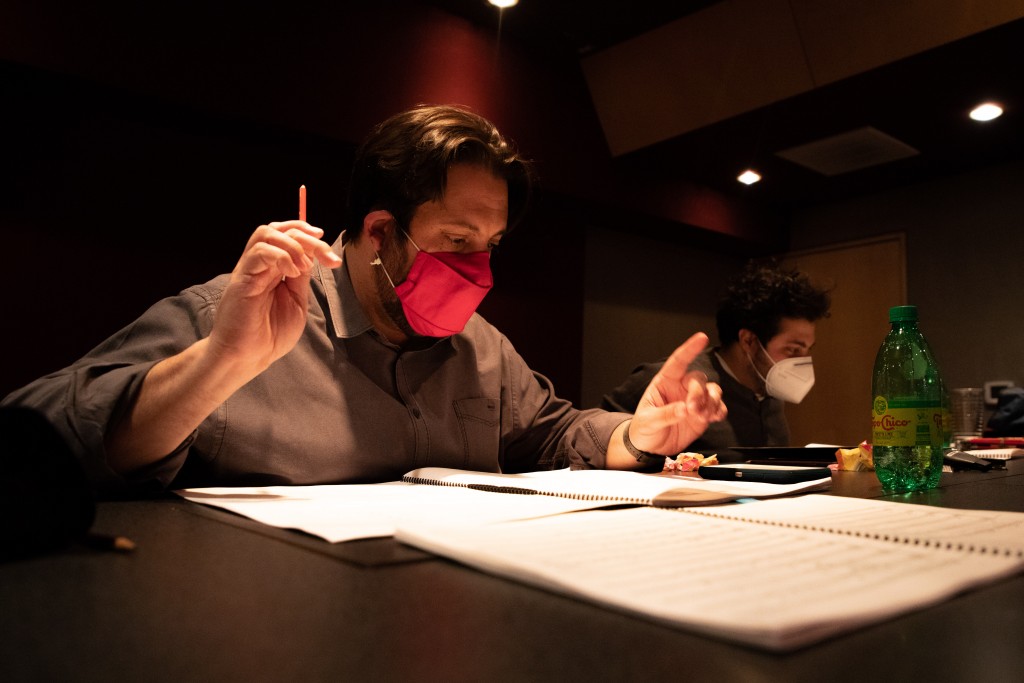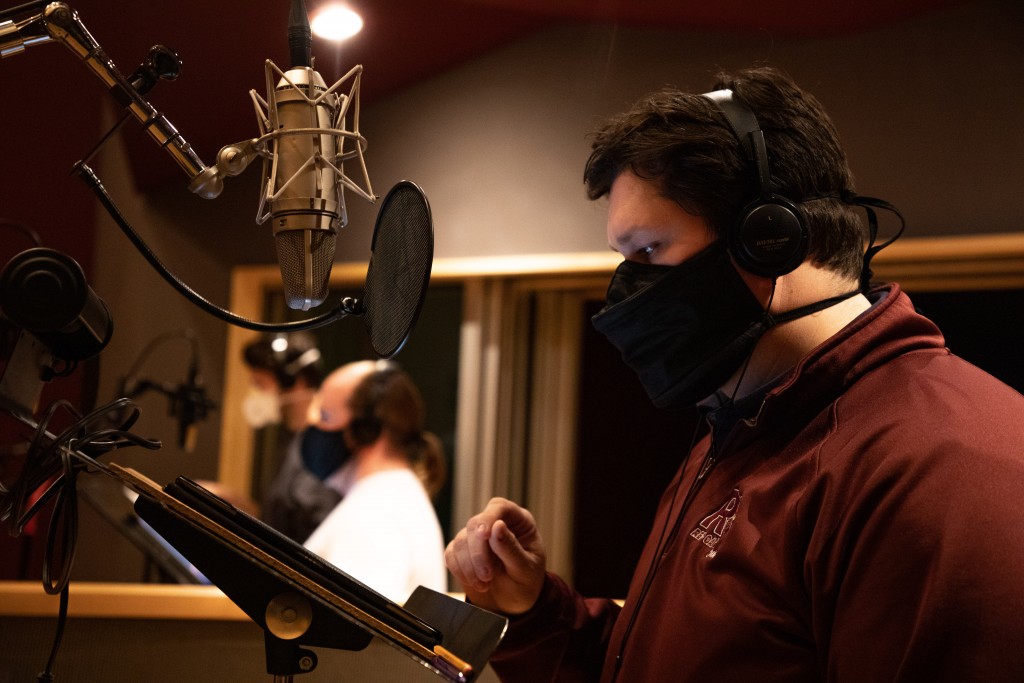This Dallas Choral Group Is Betting Big On Blockchain And Crypto-Art
ArtandSeek.net January 29, 2021 26Producer Anthony Maglione is shuffling through sheet music inside the control room of a slick recording studio in Far North Dallas.
It’s almost 10 p.m. The perfect take eludes the singers on the other side of the glass who are nearing the end of a five-hour session.

Producer Anthony Maglione (left) and Verdigris Ensemble founder Sam Brukhman look over the score sheet during a recording session with the choral group on Jan. 28, 2021. Photo: Keren Carrion.
Sam Brukhman, the founder and artistic director of Verdigris Ensemble, is sitting next to Maglione. He’s been dreaming of the choral group’s latest project for years now.
Like many live performance groups, Verdigris has had to rethink how they engage with the art market due to COVID-19, and Brukhman believes the path forward for the arts is the same technology that powers Bitcoin.
“With coronavirus happening, I had to think creatively about the sort of work I needed to do,” Brukhman said. “I started doing research and found that the digital art space in blockchain is growing. It’s exploding right now. It’s crazy.”
There’s a whole market dedicated to blockchain art, or crypto-art. Brukhman thinks Verdigris’ new music could draw big bucks in the crypto-art world. It all hinges on the successful recording of “Betty’s Notebook.”
The piece fuses electronic soundscapes with vocals to tell the true-life story of Betty Klenck, who, in 1937, claimed to have heard distress signals coming from Amelia Earhart on her family’s radio.
“It’s like we’re putting the audience in front of a really old 1930s radio and having them turn a knob to hear what Betty Klenck Brown heard,” Brukhman said. “There’s all this interference and white noise and jazz standards and other things that block us from clearly hearing what Amelia Earhart was saying that day.”
They’ve performed the piece live before. Verdigris commissioned “Betty’s Notebook,” by Texas composer Nicholas Reeves, in 2019. But this new recorded version will transform it into a one-of-a-kind digital sound installation.
Brukhman wants to use blockchain technology to create and fund the project.
“We’ve gotten very positive feedback from several museums and galleries across the world,” he said. “Whether that’s actually going to happen, I just don’t know.”

Tenor singer Alex Bumpas practices vocal exercises during the recording session on Jan. 28. Photo: Keren Carrion.
Brukhman’s brother first introduced him to the world of blockchain in 2015, and in just a few years, he’s seen how the technology has shaken up the digital art market.
Think of blockchain as a sort of record-keeping system that is collectively owned by all its users. No one can tamper with this digital public ledger, and that feature makes it a reliable way to track the origin and sale of art.
Let’s say I create a digital painting, and I post it on social media. It goes viral, and it’s shared all over the Internet. I don’t get a cent from that, and no one knows I made it.
But, what if I had created a piece of code – a unique digital token on the blockchain – attached to my painting that helped solve the problem?
“You can prove that you’re the original owner of something that exists online,” said Blake Finucane, who wrote one of the first academic papers on the use of blockchain in art. “An image that exists online. A video that exists online. In ways that have never been possible before.”
Finucane, who works for a private equity firm in Vancouver, saw the rise in popularity of these non-fungible tokens, or NFTs, in early use cases like CryptoKitties. These colorful virtual cats can be bought, sold, and traded. They use tokens to prove and track their ownership.
“It actually allows this global marketplace, where you can buy and sell your work all in front of your computer,” Finucane said. “The buyer also doesn’t have to travel. They don’t have to see your work IRL. They don’t have to see it in a gallery. It’s made actually for the digital world.”
These tokens keep track of provenance and authenticity, and Finucane said that, in turn, creates scarcity for digital work in the art market. Every token is verifiably unique, and that gives tokenized art value.
We’re not talking chump change either. In 2018, a physical art piece displaying a CryptoKitty on a tiny screen sold for $140,000.
Celestial Cyber Dimension is on display at @ChristiesInc fur the @CodexProtocol #EtherealNY charity art sale. The live auction starts tomorrow. https://t.co/jkhtKtjsb2 pic.twitter.com/GPX3lAuKEO
— CryptoKitties (@CryptoKitties) May 12, 2018
Last October, a big gray disk engraved with lines of code became the first tokenized artwork sold by a major auction house. Christie’s sold London-based artist Ben Gentilli’s “Block 21” for $131,250.
“I think [crypto-art] is particularly complimentary to the world we’ve found ourselves in for the last year and going forward now,” Finucane said. “Being at home and being less mobile in terms of where we’re allowed to go and what we have access to.”
Elena Zavelev agrees. She’s spent a lot of time explaining blockchain technology to professionals in the art world as the founder of New Art Academy in New York. She also founded the Contemporary and Digital Art Fair.
While the traditional art world is still leery of the technology, Zavelev said tokens present new monetization models, especially as more artists consider the digital space in light of COVID-19 restrictions.
“The clearest value potentially is actually artists getting paid sort of like a royalty on the resale of their works,” Zavelev said.
That’s because automatic payments from secondary sales can be built into the token attached to an artwork. Zavelev said digital works can also have multiple tokens, allowing buyers to take a stake in the work and its future value.
The possibility of more equitable pay is an attractive feature for artists in other mediums too. Audio is still new territory for the crypto-art world, but musicians are figuring out ways to use tokens to get paid fairly.
Block-chain based art marketplaces like SuperRare are bundling tokenized works with music. Tokens could be a solution for an industry where streaming is king and artists get paid pennies for streams.
But, a tokenized recording from a choral ensemble is pretty much unheard of in the crypto-art world. Brukhman wants to sell the recording for $150,000.
“We could very well at the end of this entire process, sell ‘Betty’s Notebook’ and actually make a profit,” he said. “Be able to support and give a fair wage not just to our producer, our sound engineer, our composer but also the singers.”
The choral group has poured a lot of money into this. They’ve hired an award-winning production team and purchased precious studio time. The singers have all been tested for COVID-19. Everyone is wearing masks, and there’s a high efficiency particulate air filtration system running in the studio.
“We only perform 30 minutes at a time, and we take a 15-minute break to let the air circulate and new air to come in,” Brukhman said.

Tenor singer Keith Lathrom follows the music sheet on an Ipad during the recording session on Jan. 28. Photo by Keren Carrion.
The whole project is a huge risk, and it’s hard to gauge how the art market will react.
“But, I wouldn’t do it if I didn’t truly see the vision and how it could be successful,” he said. “I see it so clearly.”
The novelty of it all could give Verdigris a leg-up with potential buyers.
Got a tip? Email Miguel Perez at mperez@kera.org. You can follow him on Twitter @quillindie.
Art&Seek is made possible through the generosity of our members. If you find this reporting valuable, consider making a tax-deductible gift today. Thank you.










